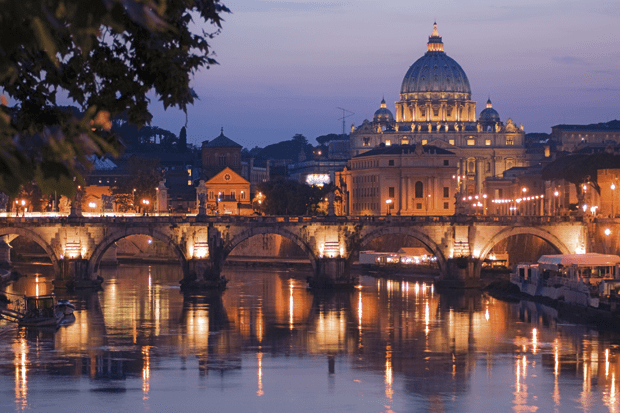Leave Florence and Sienna to the aesthetes. Let the in-crowd do Naples and Palermo. For the amateur Italophile, Rome is the destination. The eternal city is endlessly glorious, chaotic, stylish and funny: where else do you see nuns listening to iPods? Or medieval churches with condom machines by the doors?
You can barely walk ten feet without coming across something that might change your life: obelisks, piazzas, churches, gardens and statues. All that antiquity makes Roman Catholicism seem distinctly modern. And there’s the hotels. I spent a Friday night in Rocco Forte’s Hotel de Russie on the Via del Babuino, near the Spanish steps, slap-bang in the best part of town. The room was more of a suite, or what a London estate agent would call a spacious nine-bedroom apartment. Out back, you could sit and drink in the Secret Garden, surrounded by trees and birds and surgically enhanced septuagenarians, and feel like an emperor — or a mafia don. The next two nights, I stayed at the Hotel D’Inghilterra, so-called because it was a residence for 19th-century British romantics who wanted to hang out with Keats and Shelley. It is less grandiose, but equally charming. There is a James Bond bar where they played soft jazz. Not exactly ‘Ode on a Grecian Urn’, but groovy -nonetheless.
From there, I took a tour of the Vatican Museum. My Italian guide was called Fulvio De Bonis. Fulvio looked considerably less Italian than me. He was about 6ft 4 and had red hair (‘fulvo means ginger,’ he told me proudly). He was great: enthusiastic, expert, completely unpretentious — and pally with the Vatican security, which meant we were able to visit certain chambers that the rest of the crowd weren’t allowed into. I got so carried away that afterwards I marched on to the Via della Conciliazione and spent about 100 euros on Popish kitsch: Holy See fridge magnets and so on.
Rome is at once exuberant and understated. A friend told me to check out the parish church in the Piazza del Popolo. Boy I’m glad he did. Behind a relatively modest façade, Santa Maria del Popolo is a wonder. It has a domed chapel designed by Raphael, statues by Bernini, a Bramante apse and not one but two Caravaggios. (Travel tip: take a few €1 coins, since you need to feed a meter just to see the paintings in the dark.)
Capital city dwellers are increasingly expected to be not just accommodating to tourists, but somehow brand-aware. Parisians know they are meant to be romantic. Londoners know they are meant to be eccentric. Romans, by contrast, remain cheerfully oblivious. They don’t have to show off; their city does it for them.
Italy may lurch from one fiscal crisis to another. Her politicians may be the most venal in Europe. Her football hooligans may be worse than ours. But her capital will always be magnificent. As Robert De Niro put it, ‘Italy has changed. But Rome is Rome.’







Comments